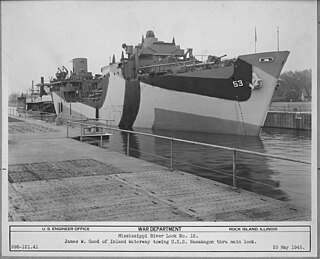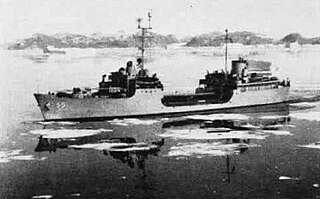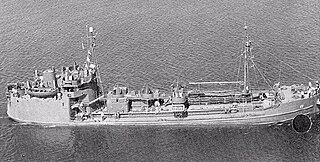
USS Namakagon (AOG-53) was a Patapsco-class gasoline tanker built for the United States Navy during World War II. In some sources, the ship's name is also spelled Namakogon. After her decommissioning from the U.S. Navy in 1957, the former Namakagon served as Antarctic supply vessel HMNZS Endeavour (A184) for the Royal New Zealand Navy (1962–1971), and as ROCS Lung Chuan for the Republic of China Navy. Lung Chuan ended active service when she was decommissioned from the Republic of China Navy in 2005.
USS Pinnebog (AOG–58) was a Patapsco-class gasoline tanker acquired by the U.S. Navy for the dangerous task of transporting gasoline to warships in the fleet, and to remote Navy stations.

USS Wacissa (AOG-59) was a Patapsco-class gasoline tanker delivered to the United States Navy in 1946. She directly put in reserve and reactivated for service with the Military Sea Transportation Service between 1952 and 1956. In 1957, she was transferred to the United States Air Force. Shortly thereafter she was again transferred to Canada. She was finally scrapped in 1964.

USS Rio Grande (AOG-3) was a Patapsco-class gasoline tanker in service with the United States Navy from 1943–1946 and 1950–1956. She was scrapped in 1972.

USS Agawam (AOG-6) was a Patapsco-class gasoline tanker acquired by the U.S. Navy for the dangerous task of transporting gasoline to warships in the fleet, and to remote Navy stations.

USS Elkhorn (AOG-7) was a Patapsco-class gasoline tanker in service with the U.S. Navy from 1944 to 1972. She was then sold to Taiwan, where she served as ROCS Hsing Lung (AOG-515/AOG-517). Her final fate is unknown.

USS Genesee (AOG-8) was a Patapsco-class gasoline tanker acquired by the U.S. Navy for the dangerous task of transporting gasoline to warships in the fleet, and to remote Navy stations.
USS Pasquotank (AOG-18) was a Mettawee-class T1 tanker type gasoline tanker acquired by the U.S. Navy for the dangerous task of transporting gasoline to warships in the fleet, and to remote Navy stations.

USS Ponchatoula (AOG-38) was a Mettawee-class gasoline tanker acquired by the U.S. Navy for the dangerous task of transporting gasoline to warships in the fleet, and to remote Navy stations.

USS Chehalis (AOG-48) was a Patapsco-class gasoline tanker acquired by the United States Navy for the dangerous task of transporting gasoline to warships in the fleet, and to remote Navy stations. The vessel was named after the Chehalis River located in Washington state.

USS Chestatee (AOG-49) was a Patapsco-class gasoline tanker in service with the United States Navy from 1944 to 1946 and with the Military Sea Transportation Service from 1952 and 1956. From 1957 to 1962, she was lent to the United States Air Force. She was sold for scrap in 1975.

USS Chewaucan (AOG-50) was a Patapsco-class gasoline tanker in service with the United States Navy from 1945 to 1975. She was then transferred to the Colombian Navy, her final disposition being unknown.

USS Maquoketa (AOG-51) was a Patapsco-class gasoline tanker in service with the United States Navy from 1945 to 1947 and with the Military Sea Transportation Service from 1952 to 1957. She was sold for scrap in 1975.

USS Mattabesset (AOG-52) was a Patapsco-class gasoline tanker in service with the United States Navy from 1945 to 1968. She was scrapped in 1969.

USS Nespelen (AOG-55) was a Patapsco-class gasoline tanker in the service of the United States Navy.
MS Transpet was a tanker of United States and Panamanian registry. Laid down as MV Avoca and acquired by the Maritime Commission (MARCOM) on a loan charter basis and renamed USS Petaluma (AOG-69), she was to be a type T1 Klickitat-class gasoline tanker built for the US Navy during World War II. She was named after the Petaluma River, in California. Petaluma (AOG-69) was never commissioned into the US Navy.

USS Natchaug (AOG-54) was a Patapsco-class gasoline tanker in service with the United States Navy from 1945 to 1959. She was directly transferred to the Greek Navy as Arethousa (A-377). The ship served a total of about 47 years in military service. Decommissioned in 2003, she was sunk as a target in 2005.

USS Pecatonica (AOG-57) was a Patapsco-class gasoline tanker in service with the United States Navy from 1945 to 1946 and from 1948 to 1961. She was then transferred to the Taiwanese Navy where she served as ROCS Chang Pei (AOG-307/AOG-507) until 2005.

The T1 tanker or T1 are a class of sea worthy small tanker ships used to transport fuel oil before and during World War II, Korean War and Vietnam War. The T1 tanker classification is still in use today. T1 tankers are about 200 to 250 feet in length and are able to sustain a top speed of about 12 knots. The hull designation AO is used by the US Navy to denote the ship is a T1 oil tanker and AOG that the T1 is a gasoline tanker. The small size allows the T1 to enter just about any sea port or to anchor around a small island, this was very useful during the Pacific War. The T1 tanker can carry about 48,000 to 280,000 bbls. Some T1 tankers were used to transport goods other than oil, a few were used for black oil-crude oil, diesel, chemicals and rarely bulk cargo like grain. T1 tankers are also called liquid cargo carriers. The T1 tanker has about a 6,000 to 35,000 deadweight tonnage (DWT) of cargo. The small size also gives the ships short turn around time for repair, cleaning, loading and unloading. A T1 tanker carrying dirty cargo, like crude oil needs a few weeks of labor to clean before carrying clean cargo. Most T1 ships during World War II were named after major oil fields.

USS Klickitat (AOG-64), was the lead ship of the type T1 Klickitat-class gasoline tanker built for the US Navy during World War II. She was named after the Klickitat River, in Washington.

















